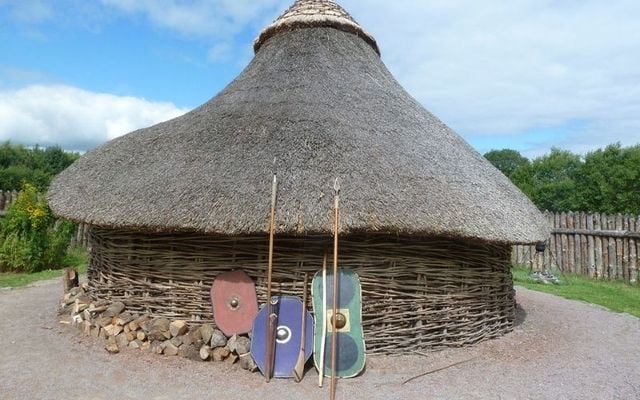Our ancient Irish ancestors ate healthily, heartily, and well. Here's how one of our writers and her family got on experimenting with the diet of 3,000 years ago.
The things I make my family do! And all in the name of research for my books and blog. Having recently investigated the diet of our ancestors, I decided to try it out for myself. Fortunately for me, they tolerate my whims and fancies quite well, even humor me a little, thinking I don't notice their exchanged glances and rolled eyes. Here are my results.
Butter
Fresh butter was highly prized by the ancestors, but as they had no fridges to keep it in, they preserved it with salt. Huge caches of butter have been found buried in bogs in Ireland, leading to the belief that perhaps it was a means of preserving or flavoring the butter. In my humble opinion, it is neither; I believe, since it was such a highly prized foodstuff, that the bog butter was placed there as a votive offering, along with all the other things that have been found in bogs.
This was the first thing that I made, and it was so easy, and so delicious, that I decided I was going to make it more often. All you need is some heavy cream and something to shake it in. I used 5oz of cream, because that's all I had left, and shook it for about 15 minutes. It made a small amount of butter, which we ate in a couple of days.
Once the butter starts to harden, you can add salt, herbs, garlic, or berries if you want to flavor your butter, and you can press it into ice-cube trays for individual portions, or shape it into a nice, neat little rectangle, like the butter you buy in the shops. I left mine as is like the ancestors would have enjoyed it, and my word, it was amazing!
Bread
In the Iron Age, there were no ovens. Bread was made by shaping small balls of dough into rounds and baking them on a stone, or later on, an iron griddle pan placed in the flames of the hearth fire until it was hot enough. There was no rising agent, although I did find a recipe for creating one from fermenting flour and water over the course of a week, but decided to give this process a miss! Perhaps another time ...
How to make Griddle Cakes: Rub 3.5oz lard or butter into 9oz wholemeal flour, adding a pinch of salt. Add 1 egg and enough milk (3-6 tablespoons) to make a firm dough. Pinch off small pieces and roll them into balls, then flatten with your hands, and place on a hot, greased griddle. Cook each side for approximately 5 minutes.
I used wholemeal spelt flour, as wheat didn't grow very well in Ireland at that time. Spelt is an ancient 'cousin' of modern-day wheat. Without a raising agent, the bread was quite dense in texture but tasty. It needs to be eaten on the day it is made. I realized that this bread is perfect for scooping up food in place of a spoon, and for soaking up the juices of meat or gravy in stews.
How to make Barley Bread: The beer gives this bread a slightly lighter texture and a strong but surprisingly delicious flavor. I liked this bread better than the Griddle Cakes. I also ground the barley into flour myself, but as I didn't have access to a quern (there is one in the County Cavan Museum down the road, but I didn't think they'd take kindly to my borrowing it), I had to make do with grinding it in my blender... not a very authentic process, I know, but it worked.

Love Irish history? Share your favorite stories with other history buffs in the IrishCentral History Facebook group.
Combine 2 cups barley flour and 2 cups wheat flour with a teaspoon of salt and rub in 8oz butter. Add enough beer to make a soft dough. Shape and cook as per Griddle Cakes above.
Wild boar stew
My day of Iron Age eating concluded with a Wild Boar Stew. Not a whole roast hog, as you might have been expecting. Not even a meal cooked a la Fianna, Fullachta Fiadh style. I quite fancied making Clay-Baked Birds, stuffed with wild garlic, onions, and leeks, as I imagine all the juices and flavors get sealed in, producing very tender, tasty meat.
The advantage this presents to the Iron-Age cook is that they don't need to pluck the birds first; removing the hard-baked clay after roasting pulls off all the feathers, a real-time and labor-saving device, I'm guessing. But the clay in my soil is full of bugs and creepy crawlies I'd rather not add to my diet, so that option was quickly discarded.
Sadly (!), I couldn't go hunting my own wild boar, as... well... there aren't any in Ireland anymore, and anyway, although I can handle a foil, I'd be no good with a spear and a Celtic-style sword. My butcher laughed me out of his shop, so I made do with two pork steaks instead.
This stew is marinated overnight and then cooked in mead or ale, juniper berries, and honey. These flavors are strong and sweet. It occurred to me that they would have been ideal flavorings to combat the salting in which meat was probably stored and preserved.
Juniper is a native tree in Ireland, which produces bluish-black berries that are dried and used to flavor beef, lamb, and pork dishes. Its aromatic wood is very soft and burned for its scent. The ancient Irish burned it at Samhain for purification purposes, and also as a means to aid in contacting and communicating with the ancestors. Nowadays, it can be used instead of mothballs to keep away pesky moths and insects.
How to make Wild Boar Stew: Marinate overnight 2.2lbs cubed wild boar/pork in 3.5 cups mead or ale, a handful of fresh thyme, parsley, and bay, and add 10 crushed juniper berries. Next day, remove the meat from the marinade and fry in 10 tablespoons dripping or lard, adding 4 chopped carrots, 1/2 a shredded cabbage, and 3/4 cup baby onions.
Return the reserved liquid, bring to a boil, adding 2 tablespoons honey and ¾cup pearl barley. When the liquid has reduced by a third, simmer half-covered for approximately 2 hours, until the sauce has thickened. Serve with barley bread or griddle cakes.
I noticed the barley soaks up the liquid pretty quick and had to add extra to mine. The finished result was tender meat and veg, very filling with the barley, which my family did not particularly like the texture of. It was also very sweet. Although subtle in this dish, juniper for me is an acquired taste that takes some getting used to.
Conclusion
Our ancient Irish ancestors ate healthily, heartily, and well! I enjoyed the experience; it really opened my eyes to one small aspect of their daily lives, and I'll definitely be making the butter and the bread again.
*Ali Isaac lives in beautiful rural Co Cavan in Ireland, and is the author of two books based on Irish mythology, “Conor Kelly and The Four Treasures of Eirean,” and “Conor Kelly and The Fenian King.”




Comments